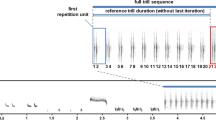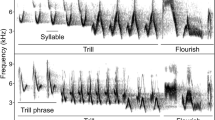Abstract
Interactive playback experiments were used to study the signal value of alternating and overlapping singing in the Yellowhammer Emberiza citrinella. We carried out interactive playback experiments in which 13 males were subjects of two treatments that differed in temporal pattern of playback song delivery (alternating vs overlapping). We measured 12 parameters of males' response, belonging to three categories: song output, call output and mobility (distance from loudspeaker and flights). The results do not confirm the hypothesis that the overlapping pattern is a signal of stronger threat, as compared to the alternating pattern. Overlapping and alternating playbacks generally elicited a similar response, characteristic for highly aroused males. The only significant difference found concerned latency of approach to the loudspeaker during the playback stage. When playback alternated with songs of males, the birds gained higher scores on the axis of that response measure. Such a result was linked to differences in how the alternating and overlapping playbacks affect detection and localisation of simulated rivals, rather than to the signal's threat value itself. The strong response of Yellowhammer males is consistent with the high intrusion rate and possibility of extra-pair copulation in this species, which probably simplifies close-range communication towards more aggressive and unequivocal repelling of rivals irrespective of the temporal patterning of song.



Similar content being viewed by others
References
Andrew RJ (1987) The aggressive and courtship behaviour of certain emberizines. Behaviour 10:255–308
Beecher MD, Campbell SE, Burt JM, Hill CE, Nordby JC (2000) Song-type matching between neighbouring song sparrows. Anim Behav 59:21–27
Brindley EL (1991) Response of European robins to playback of song: neighbour recognition and overlapping. Anim Behav 41:503–512
Cramp S, Perrins CM (1994) The birds of the western palearctic, vol 9. Oxford University Press, Oxford
Dabelsteen T, McGregor PK (1996) Dynamic acoustic comunication and interactive playback. In: Kroodsma DE, Miller EH (eds) Ecology and evolution of acoustic communication. Cornell University Press, Ithaca, N.Y., pp 398–408
Dabelsteen T, McGregor PK, Shepherd M, Whittaker X, Pedersen SB (1996) Is the signal value of overlapping different from that of alternating during matched singing in Great Tits? J Avian Biol 27:189–194
Dabelsteen T, McGregor PK, Holland J, Tobias JA, Pedersen SB (1997) The signal function of overlapping singing in male robins. Anim Behav 53:249–256
Glutz von Blotzheim UN, Bauer KM (eds) (1994) Handbuch der Vögel Mitteleuropas, vol 13. Akademische Verlagsgesellschaft, Wiesbaden.
Hansen P (1981) Coordinated singing in neighbouring yellowhammers (Emberiza citrinella). Nat Jutl 19:121–138
Hansen P (1984) Neighbour-stranger song discrimination in territorial yellowhammer Emberiza citrinella males, and a comparison with responses to own and alien song dialects. Ornis Scand 15:240–247
Hansen P (1985) Geographic song variation in the Yellowhammer (Emberiza citrinella). Nat Jutl 21:209–219
Hiet, JC, Catchpole, CK (1982) Song repertoires and seasonal song in the Yellowhammer, Emberiza citrinella. Anim Behav 30:568–574
Langemann U, Tavares JP, Peake TM, McGregor PK (2000) Response of great tits to escalating patterns of playback Behaviour 137:451–471
McGregor PK (1992) Quantifying response to playback: one, many, or composite multivariate measures? In: McGregor PK (ed) Playback and studies of animal communication. Plenum, New York, pp 79–96
McGregor PK, Dabelsteen T (1996) Communication networks. In: Kroodsma DE, Miller EH (eds) Ecology and evolution of acoustic communication. Cornell University Press, Ithaca,, pp 409–425
McGregor PK, Dabelsteen T, Shepherd M, Pedersen, SB (1992) The signal value of matched singing in great tits: evidence from interactive playback experiments. Anim Behav 43:987–998
Møller AP (1988) Spatial and temporal distribution of song in the Yellowhammer Emberiza citrinella. Ethology 78:321–331
Møller AP (1991) Why mated songbirds sing so much: Mate guarding and male announcement of mate fertility status. Am Nat 138:994–1014
Naguib M (1996) Auditory distance estimation in song birds: implications, methodologies, and perspectives. Behav Process 38:163–168
Naguib M (1999) Effects of song overlapping and alternating on nocturnally singing nightingales. Anim Behav 58:1061–1067
Naguib M, Fichtel C, Todt D (1999) Nightingales respond more strongly to vocal leaders of stimulated dyadic interactions. Proc R Soc Lond B 266:537–542
Naguib M, Klump G, Hillmann H, Grießmann B & Teige T (2000) Assessment of auditory distance in a territorial song bird: accurate feat or rule of thumb? Anim Behav 59:715–721
Osiejuk TS (2000) Repertoire and temporal organization of song bouts in the Yellowhammer (Emberiza citrinella) from western Poland. In: Tryjanowski P, Osiejuk TS, Kupczyk M (eds) Bunting studies in europe. Bogucki Wydawnictwo Naukowe, Poznań, Poland, pp 71–79
Otter K, McGregor PK, Terry AMR, Burford FRL, Dabelsteen T (1999) Do female great tits (Parus major) assess males by eavesdropping? A field study using interactive song playback. Proc R Soc Lond B 266:1305–1309
Specht R (2002) Avisoft-SASLab Pro. Raimund Specht, Hauptstr. 52, 13158 Berlin
Sundberg J (1992) Absence of mate guarding in the Yellowhammer (Emberiza citrinella)? Ethology 92:242–256
Sundberg J (1994) Paternity guarding in the Yellowhammer Emberiza citrinella: a detention experiment. J Avian Biol 25:135–141
Sundberg J (1995) Parasites, plumage coloration and reproductive success in the yellowhammer, Emberiza citrinella. Oikos 74:331–339
Sundberg J, Dixon A (1996) Old, colourful male yellowhammers, Emberiza citrinella, benefit from extra-pair copulations. Anim Behav 52:113–122
Todt D, Naguib M (2000) Vocal interactions in birds: the use of song as a model in communication. Adv Stud Behav 29:247–295
Acknowledgements
We thank John M. Burt for allowing us to use his software Syrinx to perform interactive playback experiments. We are also grateful to Konrad Hałupka, Lechu Kuczyński, Piotr Tryjanowski and two anonymous referees for critical remarks, and to Ania Labrzycka and Boszka Sikora for help with reprints. The financial support was provided by the Polish State Committee for Scientific Research (KBN grant no. 6/P04C/038/17).
Author information
Authors and Affiliations
Corresponding author
About this article
Cite this article
Osiejuk, T.S., Ratyńska, K. & Cygan, J.P. Signal value of alternating and overlapping singing in the Yellowhammer Emberiza citrinella . J Ethol 22, 55–61 (2004). https://doi.org/10.1007/s10164-003-0099-6
Received:
Accepted:
Published:
Issue Date:
DOI: https://doi.org/10.1007/s10164-003-0099-6




